

INTERIM STUDY ON ADVERSE CHILDHOOD EXPERIENCES DAVID E. BARD, PH.D. CMRI ENDOWED RESEARCH CHAIR DIRECTOR, BIOMEDICAL & BEHAVIORAL METHODOLOGY CORE ASSOCIATE PROFESSOR, DEPARTMENT OF PEDIATRICS UNIVERSITY OF OKLAHOMA HEALTH SCIENCES CENTER
THREE TAKE-AWAY MESSAGES Effects of ACEs show up early as social-emotional and general developmental dysfunction- these are telling precursors of life-long illness and disease Positive parenting practices can be learned and appear to buffer ACE impacts We can’t put all prevention eggs in one basket- must address child development and the totality of parent mental illness, substance abuse, and poverty
A NEW FRAMEWORK FOR PROMOTING HEALTHY DEVELOPMENT Early childhood adversity can lead to lifelong impairments in learning, behavior, and both physical and mental health
Repetti, Taylor & Seeman (2002). Psych Bull, 128, 330-366.
Risk as analysis and risk as feelings: Some thoughts about affect, reason, risk, and rationality. Risk Analysis, 24, 2004. Slovic, Finucane, Peters, & MacGregor
THE ACE IMPACT IN OKLAHOMA In a recent national study, Oklahoma children were among those at greatest risk for ACEs (Sacks et al., 2014) At least 10% of Oklahoma children experience 4+ ACEs Oklahoma was the only state that fell in the highest prevalence quartile for eight of the most commonly assessed ACEs. Perhaps not coincidentally, Oklahoma ranks among the worst in the nation on health conditions associated with high levels of ACEs Once again, the 2017 Commonwealth Fund ranks Oklahoma’s state health system among the very worst (49 th ) in the nation (http://www.commonwealthfund.org/interactives/2017/mar/state-scorecard/)
ACES HIGHER AMONG IMPOVERISHED FAMILIES A study of “at-risk” families in Oklahoma (families eligible for some form of government assistance with at least one child age 0-36 months) (Bard, et.al. 2015) CDC-Kaiser (N = 17,337) ACE Score MIECHV At-Risk Parents Baseline (N=1,229) 22% CDC-K vs 45.5% “at-risk” Oklahomans 36.1% 0 28.7% 26.0% 1 10.0% Experience 3+ ACEs!!! 15.9% 2 15.7% 3 9.5% 24.2% 12.5% 4+ 21.3%
PROTECTIVE EFFECT OF POSITIVE PARENTING ON CHILD WELLBEING AND DEVELOPMENT WHEN LIVING UNDER ADVERSE CHILDHOOD EXPERIENCES YUI YAMAOKA, DAVID BARD
Table 2. Effects of ACEs and parenting practices on wellbeing and development of children Being non-flourishing (6 m – 5 yr) Having risks of developmental delay (4 m – 5 yr) 95%CI 95%CI OR Lower Upper OR Lower Upper ACE score (ref: 0 score) 1 1.34 1.14 1.57 1.54 1.34 1.77 2-3 1.39 1.12 1.71 1.87 1.53 2.27 4+ 1.66 1.22 2.24 3.57 2.57 4.94 Parenting practices Reading books 0.93 0.78 1.11 0.9 0.77 1.05 Telling story 0.73 0.61 0.87 0.82 0.7 0.97 Play with peer (ref:<4days/we 0.78 0.68 0.91 0.95 0.84 1.08 children ek) Going out 0.78 0.68 0.9 0.81 0.72 0.91 Have meal with 0.92 0.77 1.1 0.84 0.71 0.99 family together (ref: >2hours 0.76 0.65 0.89 0.74 0.64 0.86 TV watching /day)
TAKE-AWAY #1: ACES APPEAR TO IMPACT EARLY DEVELOPMENT
TAKE-AWAY #2: PARENTING CAN COUNTER THE IMPACT OF EARLY ACES
Table 3. Effects of each ACE item and parenting practices on wellbeing and development of children Being non-flourishing Having risks of developmental delay All age 6 m–2 yr 3 -5 yr All age 4 m–2 yr 3 -5 yr (n = 19,557,598) (n = 8,525,973) (n = 11,031,625) (n = 20,279,499) (n = 9,236,439) (n = 11,043,060) OR 95%CI OR 95%CI OR 95%CI OR 95%CI OR 95%CI OR 95%CI ACE score 1.29 1.11 - 1.51 1.22 0.96 - 1.56 1.36 1.11 - 1.66 1.39 1.21 - 1.60 1.29 1.05 - 1.60 1.47 1.22 - 1.76 Low income Divorce 1.07 0.84 - 1.36 1.17 0.77 - 1.79 1.03 0.77 - 1.37 1.20 0.96 - 1.50 1.63 1.10 - 2.42 1.08 0.84 - 1.40 Drug abuse 0.80 0.58 - 1.09 0.68 0.40 - 1.16 0.87 0.59 - 1.27 1.17 0.88 - 1.54 0.77 0.47 - 1.24 1.35 0.96 - 1.92 Violence neighborhood 1.33 0.94 - 1.89 1.25 0.61 - 2.53 1.36 0.91 - 2.03 1.27 0.88 - 1.83 1.22 0.62 - 2.40 1.27 0.83 - 1.96 Mental illness 1.36 1.03 - 1.80 1.11 0.70 - 1.75 1.52 1.08 - 2.14 1.50 1.14 - 1.96 1.54 1.00 - 2.36 1.50 1.08 - 2.09 IPV 1.09 0.79 - 1.51 1.05 0.59 - 1.85 1.14 0.78 - 1.67 1.43 1.02 - 2.03 1.26 0.75 - 2.10 1.55 1.02 - 2.37 Incarceration 1.13 0.83 - 1.52 1.53 0.90 - 2.61 0.93 0.66 - 1.31 1.28 0.94 - 1.74 2.02 1.22 - 3.35 1.02 0.71 - 1.47 Racial discrimination 1.01 0.60 - 1.68 1.69 0.62 - 4.59 0.86 0.48 - 1.54 1.95 1.29 - 2.97 1.45 0.64 - 3.27 2.26 1.35 - 3.77 Parent died 0.92 0.51 - 1.65 0.25 0.09 - 0.71 1.29 0.69 - 2.40 1.37 0.81 - 2.32 1.25 0.42 - 3.74 1.51 0.87 - 2.61
OHIP2020.com
TAKE-AWAY #3: PREVENTION EFFORTS NEED TO ADDRESS SERVICES FOR POVERTY, MENTAL ILLNESS, AND SUBSTANCE ABUSE
Recommend
More recommend